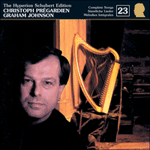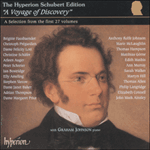
Welcome to Hyperion Records, a British classical label devoted to presenting high-quality recordings of music of all styles and from all periods from the twelfth century to the twenty-first.
Hyperion offers both CDs, and downloads in a number of formats. The site is also available in several languages.
Please use the dropdown buttons to set your preferred options, or use the checkbox to accept the defaults.

| Christoph Prégardien (tenor), Graham Johnson (piano)» More |
The accompaniment is constructed in three layers like a string trio. At the bottom (though not very deep in the bass) are long-held pedal notes (either A or E with a brief and passing visit to F natural towards the end) which the little finger of the left hand sustains for a bar at time. In the alto register are quavers (also played with the left hand) which lie at the heart of the piano part, and which intertwine with the vocal line in sensual duet. And then the right hand plays the purest and most transparent of water music, purling semiquavers which suggest a stream gentling bubbling rather than gushing. This figuration was no doubt inspired in the first instance by the word 'Schlummergeräusch' (slumbrous murmur) but its treble register also adds a touch of sparkle to the song, like flecks of water glinting here and there in the sunlight. It is perhaps for this reason that Einstein regards Der Jüngling an der Quelle as an early example of impressionism or musical pointillism.
The vocal line itself is repetitive and largely based on arpeggios, but somewhere in this folksong naiveté lies the magic ingredient that weaves a hypnotic spell. There are also a number of tiny details which contribute to the effect of the whole. As the whispering beauties of the environs kindle in the youth painful feelings of the love that he had hoped to forget, the vocal line on 'wecket die Liebe nur auf' leaps an octave from E to E, and we have a sense of the lad's heart in his mouth as almost against his will thoughts of Louise (or Luise as Mandyczewski has it) flood his memory. There could never have been an accented passing note with more of a tender ache in it than on 'Spröde' (we understand immediately that she has primly been refusing his advances, and that he is dying of frustration), nor a more a sensuously arched phrase than the second 'ach, und Blätter und Bach'. For the final three words of the poem Salis-Seewis had originally written 'Elisa mir zu' rather than 'Louise dir nach'. Although the poem is not written in rhyme, it seems that the composer was pleased to invent a rhyme in the final couplet where the original final words 'mir zu' were changed to 'die nach' to rhyme with 'Bach'. Schubert no doubt also realised that the first syllable of 'Elisa' is not easy or pleasant to sing on a long note, so he substituted 'Louise' which rolls languidly off the tongue and makes a long and plaintive vowel sound on the first syllable. That this name should be repeated twice at the very end and die on the singer's breath is also the composer's inspiration, and a very happy one. The whole song seems to make time stand still—'one no longer thinks of Salis's sentimental Louise, but of the god Pan, sleeping in the hush of noon-day.' (Einstein). The combination of its tonality (A major) and its sense of gently unfolding timelessness suggest a mystical link with Wolf's Auch kleine Dinge. There is a similar sense of indefinable perfection in both songs.
from notes by Graham Johnson © 1995
 Schubert: The Complete Songs Schubert: The Complete Songs‘This would have been a massive project for even the biggest international label, but from a small independent … it is a miracle. An ideal Christ ... ‘Please give me the complete Hyperion Schubert songs set—all 40 discs—and, in the next life, I promise I'll "re-gift" it to Schubert himself … fo ...» More |
 Schubert: The Hyperion Schubert Edition, Vol. 23 - Christoph Prégardien Schubert: The Hyperion Schubert Edition, Vol. 23 - Christoph Prégardien‘When the Hyperion Schubert Edition is finally completed I am certain that this wondrous offering will rank among its most precious jewels … Prég ... ‘Prégardien is an artist of the first rank’ (Fanfare, USA)» More |
 Schubert: An introduction to The Hyperion Schubert Edition Schubert: An introduction to The Hyperion Schubert Edition'Irresistible!' (BBC Music Magazine) 'A delightful sampler' (The Penguin Guide to Compact Discs)» More |

